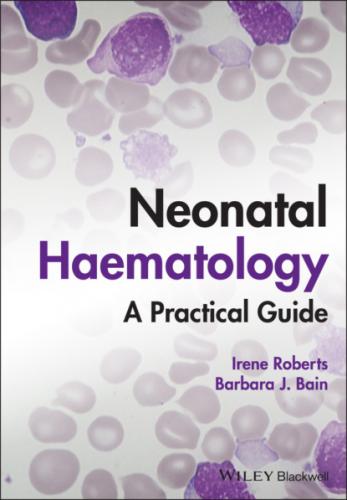Normal ranges for the numbers of circulating nucleated red blood cells (NRBC) in neonates have been compiled by Christensen et al.66 and are generally higher in preterm neonates (2–3 × 109/l) than in term neonates (about 1 × 109/l) (see Table 1.2). Although modern analysers are increasingly able to generate accurate absolute NRBC counts, a useful guide from examination of blood films is that the presence of up to 5 NRBC/100 white blood cells in a term baby and up to 25 NRBC/100 white blood cells in a preterm baby can be considered normal for the first 1–2 days of life. In fact, there seems to be no difference between results obtained when the manual and automated methods are compared.75 The number of NRBC in the peripheral blood falls rapidly over the first week of life and these cells are no longer seen after the second week of life. By contrast, circulating erythroblasts are increased in a variety of conditions in neonates and their presence can therefore be useful diagnostically because they usually indicate increased erythropoiesis driven either by anaemia or by chronic intrauterine hypoxia, for example due to IUGR (Table 1.4 and Fig. 1.10). It should be noted that NRBC also appear in the peripheral blood as part of a leucoerythroblastic picture, most typically in response to acute perinatal hypoxia (Fig. 1.11).76,77
Red blood cell morphology
Even in freshly taken samples, the morphology of neonatal red blood cells is distinctly different to that of adult cells.35,78 The most typical morphological feature that differs from what is observed at other times of life is the presence of echinocytes (see Fig. 1.8). In healthy neonates, the proportion of echinocytes in blood films made from samples collected during the first week of life is inversely proportional to gestational age at birth. Echinocytes gradually disappear from the peripheral blood film over the first few weeks of life so that even very preterm neonates will have few circulating echinocytes by 4 weeks of age (Fig. 1.12). This, together with the universal presence of echinocytes in very preterm neonates, strongly suggests that the changes reflect the unique differences in the cell membrane and metabolism of fetal red blood cells. Indeed, echinocytes are not a useful indicator of red cell pathology in neonates. Instead, other morphological indicators of red cell pathology, such as spherocytes, elliptocytes, target cells and occasionally acanthocytes, are a more reliable diagnostic guide (see Chapter 2).
Table 1.4 Causes of increased numbers of circulating nucleated red blood cells (erythroblasts) in term and preterm neonates
| Response to anaemia: haemolytic disorders |
| Haemolytic disease of the newborn (especially due to anti‐D and anti‐c) |
| α thalassaemia major (occasionally, haemoglobin H disease) |
| Severe congenital dyserythropoietic anaemia (e.g. due to KLF1 mutations) |
| Rare severe red cell enzyme deficiencies (e.g. pyruvate kinase deficiency or glucose phosphate isomerase deficiency) |
| Rare severe red cell membranopathies (e.g. hereditary stomatocytosis or autosomal recessive hereditary spherocytosis) |
| Response to anaemia: blood loss (mainly acute) |
| Fetomaternal haemorrhage |
| Placental abruption |
| Large cephalohaematoma |
| Haemorrhage into major organs, e.g. liver Twin‐to‐twin transfusion (donor twin) |
| Response to hypoxia |
| Chronic in utero hypoxia: |
| Intrauterine growth restriction |
| Maternal hypertension |
| Maternal diabetes mellitus |
| Down syndrome (mechanism unclear) |
| Acute perinatal hypoxia: |
| Hypoxic ischaemic encephalopathy (leucoerythroblastic) |
| Neoplasms |
| Transient abnormal myelopoiesis in Down syndrome* |
| Congenital leukaemia (non‐Down syndrome) |
| Other |
| Recovery phase of parvovirus B19 infection |
* The increase in circulating erythroblasts is even higher in Down syndrome neonates with transient abnormal myelopoiesis than in Down syndrome neonates in general.
Fig. 1.10 Blood film showing features of hyposplenism resulting from intrauterine growth restriction: (a) low power showing anisocytosis, poikilocytosis, target cells and some fragments (MGG, ×40); (b) high power, two Howell–Jolly bodies are apparent (MGG, ×100).
Fig. 1.11 Blood film from a preterm neonate (born at 25 weeks’ gestation) on the day of birth showing a leucoerythroblastic picture with NRBC, a myelocyte and promyelocyte as well as toxic granulation of the neutrophils and red cell morphology typical of an extremely preterm neonate. This appearance is typical of perinatal hypoxia. MGG, ×100.
Fig. 1.12 Impact of postnatal age on red cell morphology; blood films from: (a) healthy term baby; (b) neonate at a postnatal age of 4 weeks. MGG, ×100.
The presence of a small proportion (typically <5%) of spherocytes and target cells in the first few days of life is normal, particularly in preterm babies, possibly reflecting a degree of functional hyposplenism in the neonate. Consistent with this, these features are more marked in neonates with IUGR, when they are usually accompanied by the presence of Howell–Jolly bodies34 (see Fig. 1.10). The presence of
